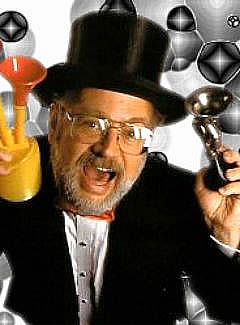
IRIS login | Reed College home Volume 96, No. 2: June 2017
Dr. Demento goes "Here, There and Everywhere"
"I Want to Hold Your Hand" began climbing the U.S. pop charts in January 1964, heralding the arrival of both the Beatles and the British Music Invasion. Though "Surfin' U.S.A." was the number two hit of 1963, the list was chockablock with such easy listening fare as "The End of the World," "Sukiyaki," "Blue Velvet" and "Puff, the Magic Dragon." Six of the top 20 hits of 1964 were by the Beatles and the list now included songs by the Supremes, the Dave Clark Five and the Animals. It was a seismic shift (though Louis Armstrong did ring in with the number two hit of 1964, "Hello Dolly').
But of course the Fab Four didn't exist in a vacuum. In a Paideia talk entitled "Here, There and Everywhere," Dr. Demento (Barry Hansen) '63 presented a curriculum vitae of music influences that shaped the Beatles and rock n' roll.
Barry presented three talks at this year's Paideia and is an ethnomusicologist who has written extensively about the recording industry. His radio show was syndicated for years on the Westwood One Radio network and is still produced online.
By the time they met in 1957, 16-year-old John Lennon and 15-year-old Paul McCartney had been exposed to generations of American music. While U.S. radio exposure to alternative music was limited to small, local stations, the British Broadcasting Company regularly sampled the new and distinctive from across the ocean. British audiences could hear everything from the mainstream Perry Como singing "Don't Let the Stars Get in Your Eyes," to "Rocket 88," a 12-bar blues song recorded in Memphis by Jackie Brenston.
Barry presented a musical progression illustrating how artists of one genre influenced another. Country artists, for example, began working black blues into their music just before World War II, when electric guitars became available.
In the late 1930s and early '40s, a black group called the Ink Spots had huge success turning simplified versions of Tin Pan Alley pop songs into sentimental ballads. This music inspired the doo-wop artists of the late '40s and early '50s, becoming a major part of framework for rock n' roll.
Cleveland deejay Alan Freed promoted a mix of blues, country and rhythm and blues, coining the phrase "rock and roll" and demonstrating that white kids loved this music as well. Small, independent record companies were excited about expanding their market.
"They quickly met stiff competition from established record companies," Barry said, "which made cover records of some of those catchy R and B songs with well-scrubbed, mainstream, white artists."
Pat Boone covered Little Richard's "Tutti Frutti," and Bill Haley covered "Shake, Rattle and Roll" by Kansas City musician Big Joe Turner. A Memphis a record producer found a good-looking white kid who could sing rhythm and blues, giving birth to the meteoric career of Elvis Presley.
Meanwhile, back in Great Britain Lennon and McCartney, like many English working class lads, were experimenting with a kind of music called skiffle. This uniquely British craze was influenced by African-American music of the early 20th century. It was a slightly modernized version of American New Orleans jazz and one of its attractions was almost anybody could perform skiffle. The first record Lennon every purchased was "Rock Island Line" by Lonnie Donegan, known as the king of skiffle.
The Beatles developed a following in Liverpool and in Hamburg, Germany, where they played clubs frequented by American servicemen. In 1961 they were invited to a Hamburg recording studio to back up British artist Tony Sheridan on nine tracks that included "My Bonnie."
A Liverpool music store salesclerk named Brian Epstein had his curiosity aroused when a kid asked for the single "My Bonnie" by Tony Sheridan and the Beatles. He discovered that the band was playing down the street, became their manager and got them an audition with Decca Records. Decca passed but EMI signed the group and their first single, "Love Me Do" was a big hit in Liverpool. Their second release, "Please Please Me," was a national hit followed by one of the best-selling singles in British history, "She Loves You."
By the time "I Want to Hold Your Hand" became their first number one hit in America, Barry said, "they had very much mastered the one thing that is very much their own, which can not be easily traced to any artist or genre, and that is the blend of their voices. John, Paul, George -- and sometimes Ringo -- singing together produced a sound that was distinctive and unmistakable."
On their early albums the Beatles covered such rock n' roll favorites as Chuck Berry's "Rock and Roll Music," the Marvelettes "Please Mr. Postman," Buddy Holly's "Words of Love," and "Twist and Shout" by the Isley Brothers.
"Their brilliant songwriting would carry them through for the rest of their career," Barry said. But the Beatles continued to absorb all kinds of music and incorporate it on their albums. They experimented with reggae on the White Album ("Ob-La-Di, Ob-La-Da"); experimented with Indian music after George Harrison bought his first sitar and incorporated a wide range of musical influences until they broke up in 1970.
Tags: alumni



LATEST COMMENTS
steve-jobs-1976 I knew Steve Jobs when he was on the second floor of Quincy. (Fall...
Utnapishtim - 2 weeks ago
Prof. Mason Drukman [political science 1964–70] This is gold, pure gold. God bless, Prof. Drukman.
puredog - 1 month ago
virginia-davis-1965 Such a good friend & compatriot in the day of Satyricon...
czarchasm - 4 months ago
John Peara Baba 1990 John died of a broken heart from losing his mom and then his...
kodachrome - 7 months ago
Carol Sawyer 1962 Who wrote this obit? I'm writing something about Carol Sawyer...
MsLaurie Pepper - 8 months ago
William W. Wissman MAT 1969 ...and THREE sisters. Sabra, the oldest, Mary, the middle, and...
riclf - 10 months ago